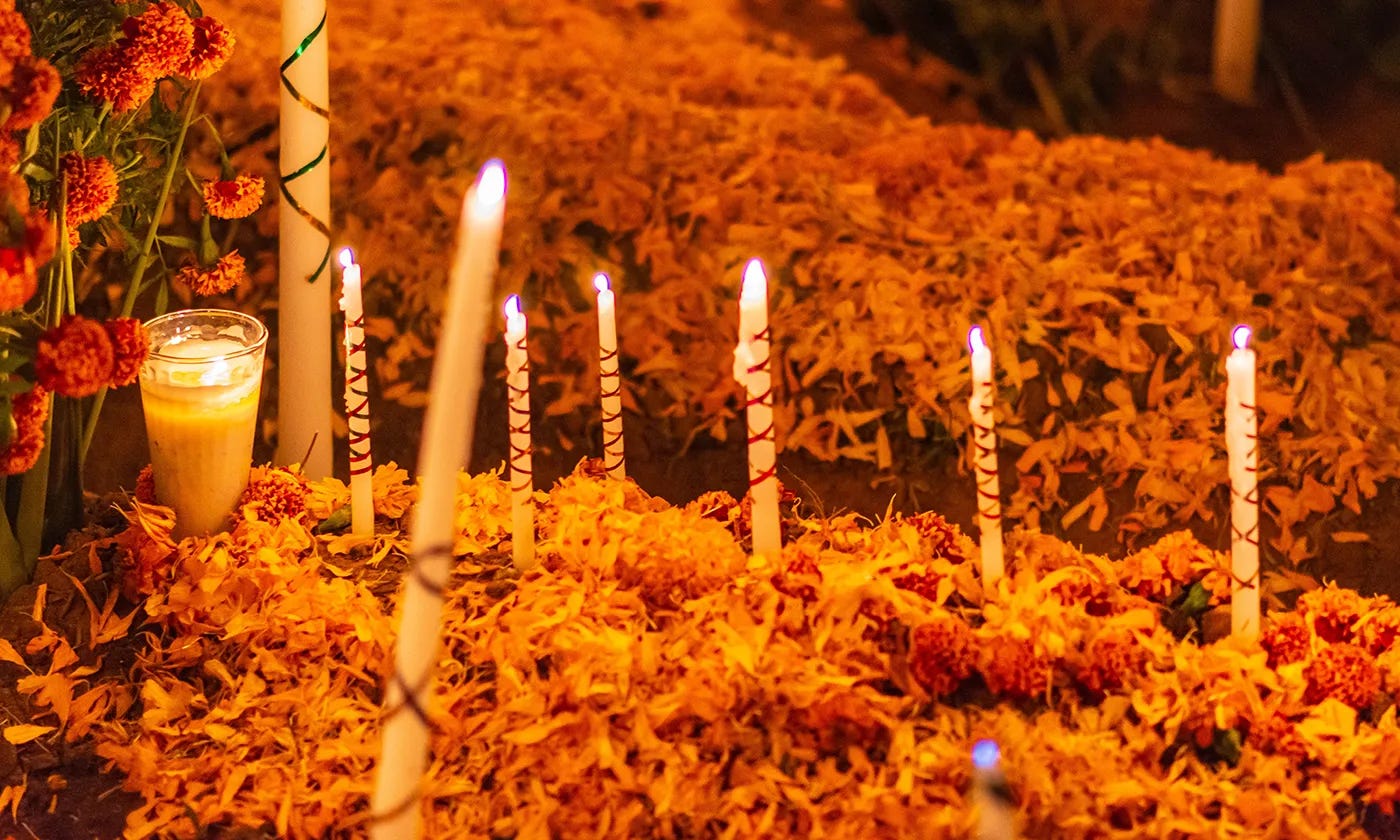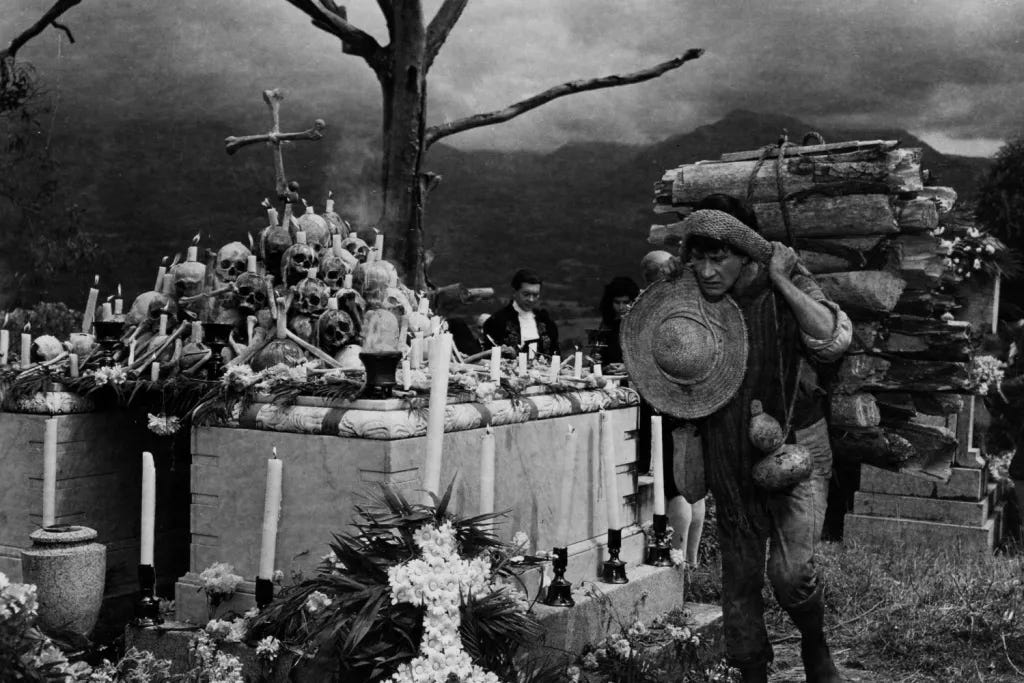Día de Los Muertos
#11 Includes a Dedicated Film/Playlist to Día de Los Muertos. Also, Last Chance to Win Michaela Coel's Misfits and a Youthquake Care Package
The Pop Culture Cold Brew is a collection of pop culture adjacency news that’s sincerely piqued our interest during these wildly unprecedented times— only without the celebrity worship culture. The Cold Brew also comes with a side of candor in critique pieces on pop culture and societal mores; get into it below.
Día de Los Muertos, while observed in Mexico and Mexican communities globally, is also celebrated throughout Latin American cultures. It’s an honoring celebration to the deceased between October 31st through November 2nd, where spirits are welcome to walk among us.
The origins of this festive celebration are deeply rooted in Aztec beliefs that Diosa Mictēcacihuātl, also known as the “Lady of the Dead,” ruled the underworld by watching over the bones of the dead— her grinning skull face is notably associated with Día de Muertos. The holiday became affixed with Catholicism after the Spanish conquests converted the Pre-Hispanics, now steeped in religion throughout the years. Still, modern observances see younger generations grasp onto both amalgamed traditions learned from our elders. The commemorative days are dedicated to the departed in three parts: October 31st for those in limbo or All Saints Day, November 1st for kids otherwise referred to as angelitos (angels), and November 2nd for adults. The veil between the living and the dead is set to be especially thin, allowing the bridge to the afterlife to connect us to the spirits of loved ones crossing who’ve died.
This sacred holiday has many rituals and traditions; this varies culturally on geographical locations. For example, many pay their respects by visiting cemeteries and, quite literally, celebrate with the dead (importantly, tombstones and gravesites are sacred and should never be stepped on or desecrated) with built altars, ofrendas like food or drinks and music. Altars are the most important aspect of this treasured holiday as representative elements include cleaning the homes before to create space for altars that carry treasured photos with plenty of mixed imagery; this also varies from indigenous/religious backgrounds. Symbolic uses of pica papel (perforated paper), keepsakes/toys, prayer candles, salt, photographs, Calacas/Calaveras (skeletons and skulls) de Azúcar (sugar), and other ornate essentials gradually build until the altar reaches its peak on November 2nd.
Another major factor is the ofrendas (offerings) to honor those who died; this can be prepared food and drinks enjoyed by the dearly departed when they were living. Traditional recipes like Pan de Muertos (Mexican bread of the dead), water, merengue, and more are important as our loved ones make the long pilgrimage from the spiritual life, which is why food offerings are a crucial step.
Leaving a place with a plate aside pays homage by celebrating loved ones; we acknowledge their importance and memory by offering them a place. Prepared food for ofrendas can be either disposed of or composted but never taken directly from their plate since they’re sacred gifts.
Perhaps the most recognizable besides the skulls are the flowers; specifically, sweet-smelling flowers like Cempasúchil’s (Mexican marigolds) or Cresta de Gallo (Cock’s comb) are vital to altars with their deep red beauty. The scent and vibrancy of the Cempasúchil guide spirits to and from their respective altars as marigolds represent the fragility of life. Mexican and Latin American cultures accept death as part of life’s cycle despite its macabre or taboo subject for most; it’s an honoring way to respect the departed souls to honor and pass on memories to celebrate life and those that bind us.
💐 Dia de Los Muertos Film and Playlist

If you’re interested and want to see more about the festive and sacred holiday, our film picks and playlist are below.
For Apple Music, HERE.
Macario (1960)
Adapted from the story The Third Guest authored by B. Traven (based on the Brothers Grimm story, Godfather Death), Macario was the first Mexican production nominated for the Best Foreign Language Film— making it a must-see for any cinephile. This Roberto Gavaldón directorial was something I watched early on with my Abuelo, who loves Mexican cinema (his love of Pedro Infante and Jorge Negrete introduced me to La Doña, María Félix).
Set in colonial Mexico on the eve of Día de Los Muertos, an impoverished and starving indigenous man, Macario (Ignacio López Tarso), is visited and tested by three mysterious deities— Devil, God, and Death. This supernatural drama is stunning and a must-see for this holiday of remembrance as it weaves in and out of magical realism.
The Halloween Tree (1993)
I thought this film was a figment of my childhood imagination for many years because it’s been that long since I’ve last seen this literary classic. Adapted from author Ray Bradbury’s 1972 novel of the same name, the 1993 Hanna-Barbera production for Cartoon Network even features narration by Ray Bradbury. Also, the iconic Leonard Nimoy.
The Halloween Tree features a group of heroic friends whose mission is to save their friends’ souls; while some argue that it’s a little dark for kids because of its taboo nature, that makes the film special. Kids are smart, and discussing death should be discussed sincerely; that way, kids don’t fear it and instead process the heartbreaking loss healthily rather than avoiding the supposed inexplicable explanation when suddenly faced.
Once Upon a Time in Mexico (2003)
In Robert Rodriguez’s El Mariachi trilogy, Once Upon a Time in Mexico, the final film is an action-packed western featuring a dynamic cast and a memorable Día de Los Muertos scene amid festivities. Growing up watching Westerns with my Abuelo and later with my dad made this trilogy a can’t-miss staple, plus Antonio Banderas and Salma Hayek’s dynamics are unmissable.
The Book of Life (2014)
The Book of Life was brought to life by extraordinary animator Jorge R. Gutiérrez and his spritely stylistic animation. Unlike other animated films, the film characters such as La Muerte and Xibalba resemble wooden figures, creating gorgeous animations and charming beloved songs.
This hidden gem features a strong-willed and subversive Latinx after my heart and some really fun music that my nieces and nephew love. Animation is for everyone, and this kaleidoscopic film is a must-watch; bonus, Guillermo del Toro produced the vivid and timeless film.
Coco (2017)
Perhaps the most notable due to the box-office success, Coco is one of the most visually dazzling Pixar films with a massive cultural significance. For many reasons, Coco is a special film, but how it’s helped my family is what never escapes me. Not only did the film help through familial bereavement when least expected, but it also introduced me to the song Remember Me.
No matter the version, the song’s been a blessing since the film’s release due to the soothing and beautifully touching words. I’m not the best singer, but it’s brought tremendous comfort whenever my nephew, Atticus, has needed it during an Autistic meltdown.
The Adrian Molina directorial, with a co-direction with Pixar studios legend Lee Unkrich, centers around a twelve-year-old aspiring musician living in the fictional town of Santa Cecilia, Mexico.
Miguel Rivera’s heart is set on making his musical dreams a reality despite his family’s pleas for shoemaking and their enigmatic distaste for any music— proving that blazing trails and facing intergenerational trauma can lead to extraordinary breakthroughs.
Time away can be extremely beneficial, especially as we’re all still reeling from an ongoing pandemic and seemingly useless governments vilifying constituents. As I briefly mentioned in my review of Netflix’s MAID, my sister is currently going through it by detoxifying her life of abuse. As she’s been living with me for almost a year now, and most recently, helping her place structured boundaries has been quite eye-opening and arduous. At the same time, it’s not my story; but being on the other side of such a toxic environment has empowered my family and us all the more to break the traumas of our collective past further. So on this beautiful day of remembrance, we’re eternally grateful for our readers and anyone who finds their way to Youthquake.
Lastly, I mentioned the possibility of winning Michaela Coel’s new book, Misfits. One lucky and randomly drawn ACTIVE Youthquake SUBSCRIBER (free or paying) will earn a free copy of the ‘personal manifesto’ and some other surprises by way of a care package from yours truly. All you have to do is actively follow via Subscription. That’s it; I’ll notify the winning person THIS WEEK on November 6th. Good luck to all!













